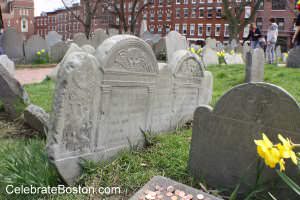The Lighthouse Tragedy
Boston Light was the first light station built in America. In 1716, the town of Hull formed a committee and successfully petitioned the General Assembly to appoint George Worthylake as the first light-keeper. On November 3, 1718, Worthylake, his wife Ann, daughter Ruth, and three others, drowned while returning to the island after attending church in Boston. About one month later, an enterprising twelve-year old boy named Benjamin Franklin wrote a ballad called The Light House Tragedy. He sold a printed handbill of the song in the streets of Boston, which gave this event its nickname.
George Worthylake was appointed keeper of Boston Light at Beacon Island (Little Brewster) in 1716. His salary was £50 per year, and was increased to £70 in 1717. The job entailed maintaining a light at the top of the tower, and as Harbor Master and pilot. The Harbor Master would be summoned by ships entering the port, and would guide the vessels into the harbor. It is also possible he possessed the authority to deny entry or to quarantine ships if he believed they were carrying passengers with communicable diseases.

On November 3, 1718, Worthylake, his wife and 15-year old daughter, and three others, were drowned after attending church in Boston. The November 10, 1718 Boston Newsletter describes the accident:
"On Monday last the 3d currant an awful and lamentable Providence fell out here. Mr. George Worthylake, (Master of the Light-House upon Great Brewster (called Beacon Island) at the entrance of the harbour of Boston), Anne his wife, Ruth their daughter, George Cutler, a servant, Shadwell their negro slave, and Mr. John Edge a passenger; being on the Lord's Day here at sermon, and going home in a sloop, dropt anchor near the landing place, and all got into a little boat or cannoo, designing to go on to shoar, but by accident overwhelmed it, so that they were drowned, and all found, and interred except George Cutler."
Three days later, Mr. Robert Saunders was tasked "to repair to Beacon Island & take care of the Light House till a keeper be chosen & appointed by the General Assembly." Less then two weeks later, Saunders and another man also drowned at Boston Light, which is likely what inspired Ben Franklin to write his Light House ballad. The November 17, 1718 Boston Newsletter describes the second accident:
"There being a necessity to supply Mr. Worthylakes place to keep up the lights on that island, Capt. Robert Saunders and two others, viz [namely] John Chamberlin and one Brad[d]uck, were appointed to go down, who accordingly went on Fryday [November 14] last, to the Light House about three a clock, and a ship coming in from sea put out a waft [beckon]; and Capt. Saunders with the other two went on board her, and Capt. Saunders inquired, if they wanted a pilot, seeing they made a sign for them. The master said, no, he only wanted to know what news; whereupon Capt. Saunders told him, that if had known so much we would not have ventur’d aboard in such stormy weather, so returning to their boat to come on shore; a saw of wind overset her, Capt. Saunders & Bradduck both drowned, Mr. Chamberlin swam directly to the shore, but rested upon...rocks, ere he got on shore, where he laid before the fire and begun to revive, and is now lying sick in Boston."
Benjamin Franklin, a brilliant and enterprising 12-year old boy, quickly wrote a song about the drownings, and called it The Light House Tragedy. He printed the ballad on handbills and sold them in the streets of Boston. His father was not pleased, and told his son to seek other career paths. Franklin, in his autobiography, described the ballad as "wretched stuff, in the Grubstreet-ballad style," although it sold wonderfully. He also stated the tragedy had "made a great noise" in the town. An original handbill may still exist today, but this author has been unable to find a copy.
There have been reports that the Worthylakes had a daughter named Ann, and that she watched the tragedy from the lighthouse. It is most likely a second daughter never existed, as she would have likely attended church in Boston with the rest of the family that fateful day.
The famous triple headstone for the Worthylakes still stands today at Copp’s Hill Burying Ground. Walk down the center of the cemetery from the front entrance, and the marker is located at the first path on the left. There is a modern tablet on the ground at the edge of the stone.
Contact Information & Address:
Copp's Hill Burying Ground
Hull & Snowhill Streets, Boston, MA
617.635.4505
cityofboston.gov
